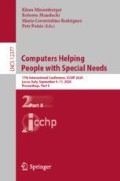Abstract
The Special Thematic Session on hearing systems and accessories is made up of a wide range of papers that illustrate different aspects of using such technologies in different environments. Studies shows the possibilities for improvements in higher education, captioning, sign language interpretation, communication for deaf-blind people and in museums.
Access this chapter
Tax calculation will be finalised at checkout
Purchases are for personal use only
References
Brauer, B.A., Braden, J.P., Pollard, R.Q., Hardy-Braz, S.T.: Deaf and hard of hearing people. In: Sandoval, J.H., Frisby, C.L., Geisinger, K. F., Scheuneman, J.D., Grenier, J.R. (eds.) Test Interpretation and Diversity: Achieving Equity in Assessment, pp. 297–315. American Psychological Association (1998)
Behm, G.W., Kushalnagar, R.S., Stanislow, J.S., Kelstone, A.W.: Enhancing accessibility of engineering lectures for deaf & hard of hearing (DHH): real-time tracking text displays (RTTD) in classrooms. In: ASEE Annual Conference & Exposition, Seattle, Washington (2015). https://doi.org/10.18260/p.23995
Bogdanova, S.: Forms and methods of work with hard of hearing students at technical higher educational institutions in the “jurisprudence” discipline. In: Unpublished Paper for the 17th International Conference on Computers Helping People with Special Needs (2020)
Capitão, S., Almeida, A.M.P., Vieira, R.M.: Connecting families and schools of students with deafness: describing the ICT and internet use in education. Procedia Comput. Sci. 14, 163–172 (2012)
Dammeyer, J., Nielsen, A., Strøm, E., Hendar, O., Eiríksdóttir, V.K.: A case study of tactile language and its possible structure: a tentative outline to study tactile language systems among children with congenital deafblindness. J. Commun. Disord. Deaf Stud. Hear. Aids 3(2), 1–7 (2015)
Datta, P., Jakubowicz, P., Garcia, J., Hwang, C., Vogler, C., Kushalnagar, R.: Readability of punctuation in both automatic and human-generated subtitles. In: Unpublished Paper for the 17th International Conference on Computers Helping People with Special Needs (2020)
Downey, G.: Constructing “Computer-Compatible” stenographers: the transition to real-time transcription in courtroom reporting. Technol. Cult. 47(1), 1–26 (2006)
EPRS: Assistive technologies for people with disabilities, Part II: Current and emerging technologies. European Parliament, Brussel (2018)
Gjøsæter, T., Radianti, J., Chen, W.: Universal design of ICT for emergency management. In: Antona, M., Stephanidis, C. (eds.) UAHCI 2018. LNCS, vol. 10907, pp. 63–74. Springer, Cham (2018). https://doi.org/10.1007/978-3-319-92049-8_5
Light, J., et al.: Challenges and opportunities in augmentative and alternative communication: research and technology development to enhance communication and participation for individuals with complex communication needs. Augmentative Altern. Commun. 35(1), 1–12 (2019)
Marschark, M., Tang, G., Knoors, H.: Bilingualism and Bilingual Deaf Education. Oxford University Press, USA (2014)
Nordin, N.M., Zaharudin, R., Yasin, M.H.M., Din, R., Embi, M.A., Lubis, M.A.: ICT in education for deaf learners: teachers’ perspective. Res. J. Appl. Sci. 8(2), 103–111 (2013)
Pyfers, L.: Sign 2.0: ICT for sign language users: information sharing, interoperability, user-centered design and collaboration. In: Miesenberger, K., Karshmer, A., Penaz, P., Zagler, W. (eds.) ICCHP 2012. LNCS, vol. 7383, pp. 188–191. Springer, Heidelberg (2012). https://doi.org/10.1007/978-3-642-31534-3_29
Ruberg, K.: Untreated disabling hearing loss costs billions – in the US and the rest of the world. The Hearing Review (2019)
Samčović, A.: Accessibility of services in digital television for hearing impaired consumers. Assistive Technology (2020)
Shield, B.: Hearing loss – Numbers and costs. evaluation of the social and economic costs of hearing impairment. Brunel University, London (2019)
Tanaka, K.: A study examining a real-time sign language-to-text interpretation system using crowdsourcing. In: Unpublished Paper for the 17th International Conference on Computers Helping People with Special Needs (2020)
Onishi, J., Miura, T., Okamoto, T., Matsuo, M., Sakajiri, M.: Distance communication assistant system for deaf blind person. In: Unpublished Paper for the 17th International Conference on Computers Helping People with Special Needs (2020)
Vestergaard, K.L., Öberg, M., Nielsen, C., Naylor, G., Kramer, S.E.: Factors influencing help seeking, hearing aid uptake, hearing aid use and satisfaction with hearing aids: a review of the literature. Trends Amplification 14(3), 127–154 (2010)
Waldow, K., Fuhrmann, A.: Addressing deaf or hard-of-hearing people in avatar-based mixed reality collaboration systems. In: IEEE Conference on Virtual Reality and 3D User Interfaces Abstracts and Workshops (VRW), pp. 595–596. IEEE (2020)
Wakatsuki, D., Arai, T., Shionome, T.: Analysis of the gaze behavior in deaf and hard-of-hearing students during a captioned lecture. In: Unpublished Paper for the 17th International Conference on Computers Helping People with Special Needs (2020)
Wakatsuki, D., Kobayashi, M., Miyagi, M., Kato, N., Namatame, M.: Survey for people with visual impairment or hearing loss on using museums in Japan. In: Unpublished Paper for the 17th International Conference on Computers Helping People with Special Needs (2020)
WHO and ITU: Safe Listening Devices and Systems: A WHO-ITU Standard. Geneva: World Health Organization and International Telecommunication Union (2019)
Author information
Authors and Affiliations
Corresponding author
Editor information
Editors and Affiliations
Rights and permissions
Copyright information
© 2020 Springer Nature Switzerland AG
About this paper
Cite this paper
Debevc, M., Vogler, C. (2020). Hearing Systems and Accessories for People with Hearing Loss. In: Miesenberger, K., Manduchi, R., Covarrubias Rodriguez, M., Peňáz, P. (eds) Computers Helping People with Special Needs. ICCHP 2020. Lecture Notes in Computer Science(), vol 12377. Springer, Cham. https://doi.org/10.1007/978-3-030-58805-2_21
Download citation
DOI: https://doi.org/10.1007/978-3-030-58805-2_21
Published:
Publisher Name: Springer, Cham
Print ISBN: 978-3-030-58804-5
Online ISBN: 978-3-030-58805-2
eBook Packages: Computer ScienceComputer Science (R0)

